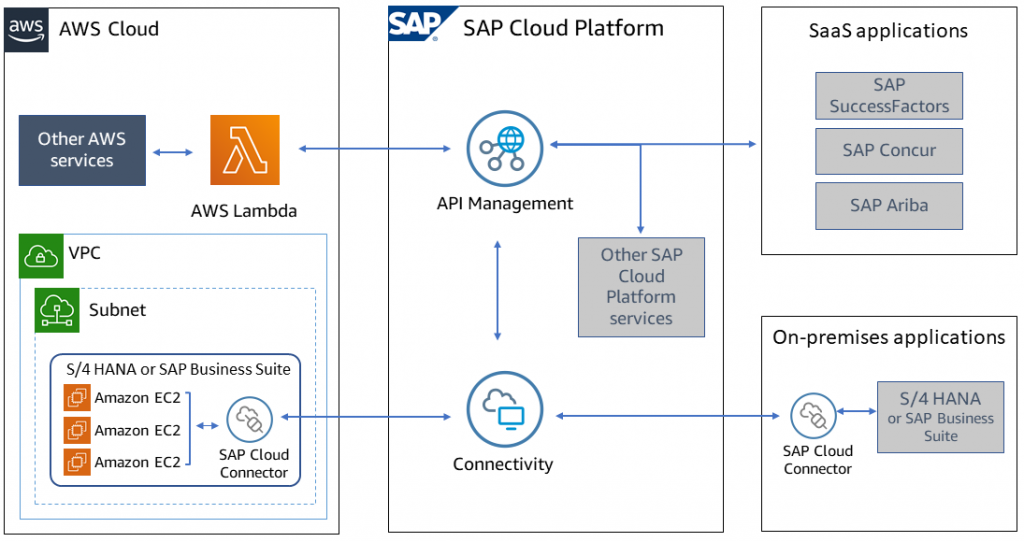AWS for SAP
Accelerate your innovations by using SAP Cloud Platform on AWS
The business benefits of running SAP workloads on AWS are already well proven with thousands of customers now running such workloads. Tangible benefits like those experienced by ENGIE, an international energy provider, include not only cost savings but also flexibility and speed. For example, as mentioned in an ENGIE case study, ENGIE was able to reduce the expected delivery time of new business frameworks by two times, when they upgraded their SAP platform to SAP S/4HANA on AWS. They did this all while rightsizing their HANA infrastructure, by using AWS-enabled high availability architecture patterns.
Although these are very tangible business benefits, customers are also increasingly looking at driving business innovations by extending core SAP business processes in the areas of Big data & analytics, Internet of Things (IoT), Apps & APIs, DevOps, and Machine learning. In fact, we discussed this SAP extension approach using AWS native services in a Beyond infrastructure: How to approach business transformation at startup speed blog post last year. Over the course of a year, we’ve been working with customers using many of the approaches detailed in that post.
As more and more customers move their SAP estates to AWS, they have also asked for help with additional reference architectures and integration patterns to extend these significant investments, through a combination of SAP Cloud Platform and AWS services.
A solid foundation for building SAP extensions
A building is only as strong as its foundation, and this is also true for any technology platform. As detailed in the SAP Cloud Platform Regions and Service Portfolio document, more than 160 SAP Cloud Platform services are now supported across seven global AWS Regions (Montreal, Virginia, Sao Paulo, Frankfurt, Tokyo, Singapore, and Sydney). Out of this total number of services, 37 of them—which include some of the more foundational digital transformation services like SAP Leonardo Machine Learning Foundation, SAP Leonardo IoT, and SAP Cloud Platform Enterprise Messaging—run exclusively on AWS infrastructure. Global availability, scalability, and elasticity are vital components of any platform as a service (PaaS). With the depth and breadth of SAP Cloud Platform services on AWS, you now have unparalleled opportunities to build SAP extensions on a solid infrastructure foundation.
Interoperability between platforms
You also have multiple options to extend, integrate, and interoperate between AWS services and SAP Cloud Platform, beyond just the services provided natively via SAP Cloud Platform. Let’s look at a few examples.
Simplify cross-cloud connectivity using SAP Cloud Platform Open Connectors
SAP Cloud Platform Open Connectors provides pre-built connectors to simplify connectivity with AWS services and to consume higher-level APIs. This service abstracts cross-cloud authentication and connectivity details, so your developers can focus on building business solutions and not worry about lower-level integration services.
For example, using Open Connectors, you can integrate Amazon DynamoDB with your web applications running on SAP Cloud Platform. Another example is integrating higher-level artificial intelligence (AI) services like Amazon Rekognition with predictive analytics solutions on SAP Cloud Platform.
Getting started with Open Connectors is easy. You can create a new connector or use an existing one.
To access an AWS service—for example, an Amazon Simple Storage Service (Amazon S3) bucket:
- Launch the Open Connectors configuration from the SAP Cloud Platform console, and then provide the service endpoint URL.
- In Authentication, choose awsv4, and then provide the required AWS authentication information.
Now you can access the AWS service as REST API calls in your applications and other services in SAP Cloud Platform.
Integrate SAP Cloud Platform API Management using AWS Lambda
AWS developers can also consume SAP Cloud Platform services by using AWS Lambda and SAP Cloud Platform API Management. This pattern is especially attractive for customers who want to mesh business processes powered by SAP S/4 HANA applications with AWS services by using SAP Cloud Platform Connectivity.
This pattern also opens up access to other higher-level services running on SAP Cloud Platform, and connectivity to other software-as-a-service (SaaS) applications such as SAP SuccessFactors, SAP Concur, and SAP Ariba. For example, let’s say you want to build a voice-enabled application for accessing inventory information from a backend SAP enterprise resource planning (ERP) application running on Amazon Elastic Compute Cloud (Amazon EC2). You can expose the inventory data as APIs using SAP Cloud Platform API Management, and consume it in a Lambda function over HTTPS. Then, you can create an Alexa skill and connect it to this Lambda function, to provide your users with functionality for voice-enabled inventory management.
See it at SAPPHIRE NOW
These are just a few examples of how to start integrating SAP Cloud Platform services with AWS services. Want to learn more? Stay tuned for a special blog series devoted to this topic and, if you are at SAPPHIRE NOW 2019, come visit our Build On bar in AWS booth 2000. You will experience feature-rich demos and can talk 1:1 with an SAP on AWS expert, to learn more about building your SAP innovation journeys on AWS. For more information on where to find us, see the Amazon Web Services at SAPPHIRE NOW website. Not attending SAPPHIRE NOW? Feel free to contact us directly for more information. Hope to see you soon, and Build On!



